The term saccharide, which means sugar, comes from carbon, hydrogen and oxygen-based molecules that are present in our foods, for example, foods and greens.
Unlike essential amino acids and fatty acids, there are no essential carbohydrates. This means we can obtain everything we need nutritionally from other food sources, so carbohydrates are not necessary to maintain life. This is brought much debate over the inclusion and requirements of carbohydrates in our daily diets and where we should fit into it. Some experts claim we do not need them in our diets, while others suggest they should never be excluded.
Dietary carbohydrates exist in three major classes, the monosaccharides, oligosaccharides, and polysaccharides. Within these three groups, we can further break down the categories into specific carbohydrate types. And you can see these within those major classes in this table as well
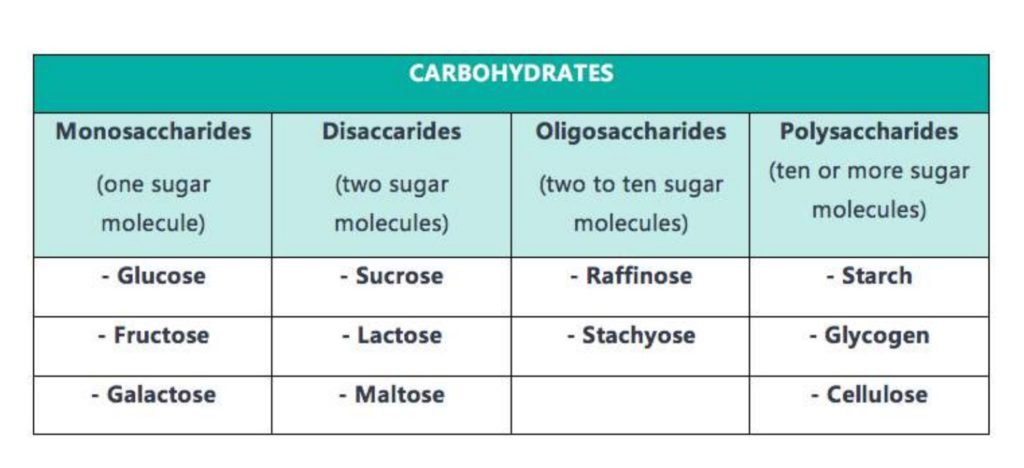
Now something to note here is the carbohydrates are grouped into these categories. Due to the variations in their molecule structure, ie, 1 to 10 Plus molecules.
Therefore, disaccharides are typically classified under oligosaccharides as they contain two molecules.
First up are the monosaccharides. This is the simplest form of carbohydrate molecule. The term mono meaning they only contain one subunit of sugar. The three most important monosaccharides are glucose, fructose, and galactose. These are known as simple carbohydrates and are recognised by their sweet taste.
Glucose is the body’s preferred type of carbohydrate and is usually the end product after the body digests the more complex carbohydrates. Glucose is what we measure in blood and therefore also serves as a transport molecule. Glucose is therefore easily used by the body and is typically applied in the following three step process.
Firstly, it’s used for immediate energy.
Secondly, it’s stored within muscle or liver cells.
Thirdly, it can be converted to triglycerides to be stored as body fat for later use.
Fructose is another monosaccharide that has to be metabolised within the liver in order for it to be converted to glucose. This is fine in many natural and artificial foods and is considered the sweetest of the carbohydrates. Hence the popularity in food manufacturing.
The last important monosaccharide is galactose. Just like fructose, this carb molecule must be metabolised in the liver, and will then be used in the same manner as glucose by the body. Unlike the other two monosaccharides galactose is not typically found alone in foods but joined with other molecules to form disaccharides.
Next, we have the oligosaccharides. When monosaccharides join, they form disaccharides meaning two molecule bonds and oligosaccharides are 2 to 10 molecule bonds. These then become complex carbohydrates and are commonly found in three main carbohydrate types: sucrose, lactose and maltose.
Sucrose is also known as table sugar and is therefore the most popular oligosaccharide. This carbohydrate occurs naturally in many of our foods like fruits, beet sugar and cane sugar. It is essentially a combination of glucose and fructose.
Lactose is another disaccharide, yet it only exists in animal milk from lactating animals, and is a combination of glucose and galactose. The body requires a special digesting enzyme called lactase to digest this type of carbohydrate.
The last important disaccharide is maltose, which is a combination of two glucose molecules. In nature this occurs during the sprouting of seeds, but it can also be artificially induced and that’s known as malting by the introduction of heat, this process is usually seen in the production of alcohol and they use this carbohydrate to provide a sweet taste in products.
The last of the saccharide categories are the polysaccharides, meaning a bonding of 10 or more molecules to form a linear or complex change. A perfect example is glucose. A homopolysaccharide is one that is made of 10 or more monosaccharides or from two or more different monosaccharide types like glucose and fructose, when they are branched. This simply means that they are bonded.
The images you can see now actually summarises this information,
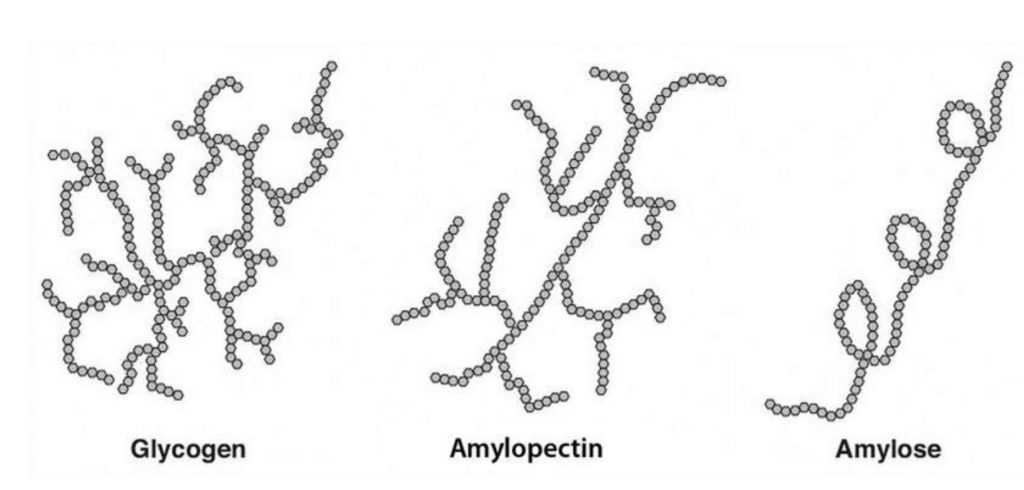
We have unbranched which are linear homopolysaccharides. And then when branched we can see how that structure changes, and we also have unbranched, linear heteropolysaccharides. And again, that structure changes once they are branched. These types of saccharides are typically found in animal and plant sources. And the two main groups of polysaccharides are starch and fibre.
First up are starches. The starch molecule is the storage form of carbohydrates in plants. So, greens and potatoes for example. Within starch we have two forms, amylose and amylopectin.
Amylose is a linear chain containing hundreds of glucose units. Amylopectin is a branch chain containing 1000s of glucose units. foods containing a high level of amylopectin tend to have a higher glycaemic index as they increase blood sugar levels the most due to the larger surface area available during digestion. Starches that are not digested in the stomach, so they remain intact, are known as resistant starches, and may then be broken down in the gut to benefit gastrointestinal health.
Humans and animals store glucose energy from starches in the form of the very large molecules called glycogen. This is typically stored in the muscle and liver cells and provides quick energy due to its highly branched nature. This process is known as glycogenesis.
Dietary fibre is considered a non-starch structural polysaccharide, examples are pectin, gum and cellulose. These fibres are found in plants and despite the large benefits to our health, they can only be broken down by the large intestine.
Next, then is the glycaemic index, or the GI is a popular concept used to determine the effect of certain carbohydrates on blood sugar levels in the body. It therefore represents the metabolic response of the body to the carbohydrates that we eat, and it’s classified into three groups.
First is the low GI foods, which is giving a less than 55 GI value,
Then medium GI foods, which is between 56 and 69 GI value,
Lastly high GI foods, which is 70 or greater on the GI value.
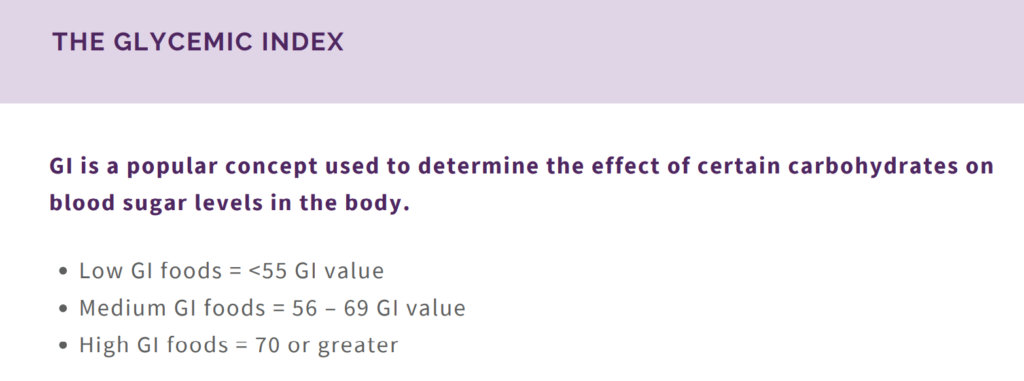
Foods that have a low GI do not raise blood glucose levels as much nor as fast as foods that have a high GI. The GI for a particular carbohydrate is primarily dependent on the rate at which the food is digested. The GI index ranking is based on a standard food such as white bread or pure glucose, which is given the arbitrary glycaemic index of 100.
There are several important factors that will affect the digestion rate of carbohydrates, namely the type of carb the amount of carbs, the fibre content, and proportion of the other macronutrients present.
The initial decision to create the GI was based on the study showing that we should be eating a diet low in GI foods to improve body composition and health. Recent research shows no correlation between the GI of food and cardiovascular diseases, but it is a great tool to highlight how various carbohydrates will impact blood sugar levels, and how the body may respond based on this as well.
The glycaemic load.
The main problem with using the GI is that it only counts for the type of carbohydrate and not the amount. Therefore, the glycaemic load or GL was introduced to represent the glycaemic index and the carbohydrate content in a serving of carbohydrates, thus representing the quality and quantity.
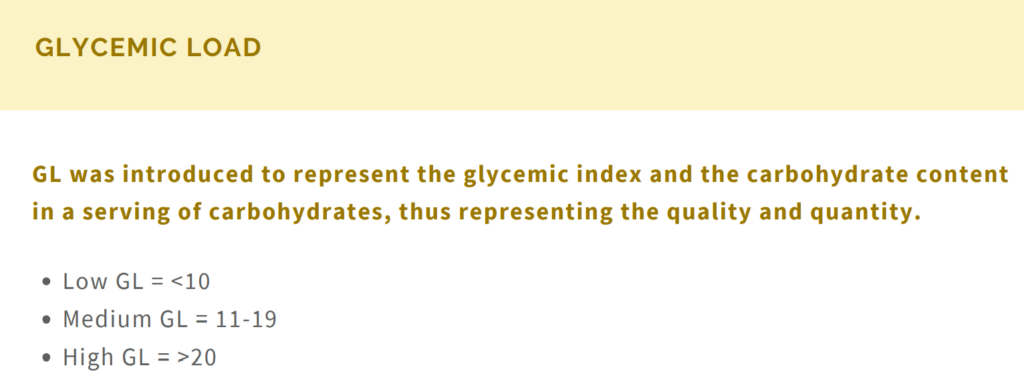
The ranking system works like the standard GL. As the higher GL, the greater the expected increase in blood sugar levels. The glycaemic load is calculated by multiplying the glycaemic index of a food by the grams of carbohydrates per serving size. Foods with a greater amount of protein, fat or acidity, will help blank the glucose response improving blood sugar levels. The glycaemic load of a food is actually classified slightly different, but we have three main groups low glycaemic load, which is less than 10, medium glycaemic load, which is between 11 and 19 and high glycaemic load which is over 20.
Now let’s look at the role of carbohydrates. Although not essential in the diet. Carbohydrates can have some important functions to play. It can be a primary source of energy for the body and brain, it can be protein sparing, and will prevent ketosis, it can facilitate the body’s metabolism of fat, is a source of B vitamins for cholesterol metabolism. And of course, it can determine the fibre content of the diet, the glycaemic load of the diet and actually the nutrient density and phytochemical content too.
The metabolization of carbohydrates can be a very complex topic when examining on a cellular level. To simplify this, the cellular use of carbohydrates depends on their absorption from the gastrointestinal tract into the bloodstream.
To achieve this, all carbohydrates must be in the form of monosaccharides. The body must break down polysaccharides and disaccharides through hydrolysation before absorption can occur. Carbohydrates can be metabolised by two different pathways, firstly is the anaerobic pathway, and secondly, the aerobic pathway. There’s no clear definition of exactly how many carbohydrates should make up our diets as what might be right for one person may not be right for the next, an individual’s optimal intake depends on age, gender, body composition, activity levels, personal preference, food, culture, and even current metabolic health.
When looking at the metabolic processes and their ability to supply energy for athletic performance, it’s very clear that carbohydrates are essential components of an athlete’s diet. Therefore, people who are physically active and have more muscle mass can tolerate a lot more carbohydrates than those who are sedentary. metabolic health is also a very important factor. As for those with metabolic syndrome, obesity, or type two diabetes, the rules change significantly. Those who fall into this category can’t tolerate the amount of carbohydrates as those who are healthy.
Study shows that a lower carbohydrate diet reduces appetite, meaning overall caloric intake is lowered. Studies also show that a lower carbohydrate diet will provide better fat loss compared to a lower fat diet. A lower carbohydrate diet can also improve health markers, such as lowering blood sugar, blood pressure, and triglycerides.
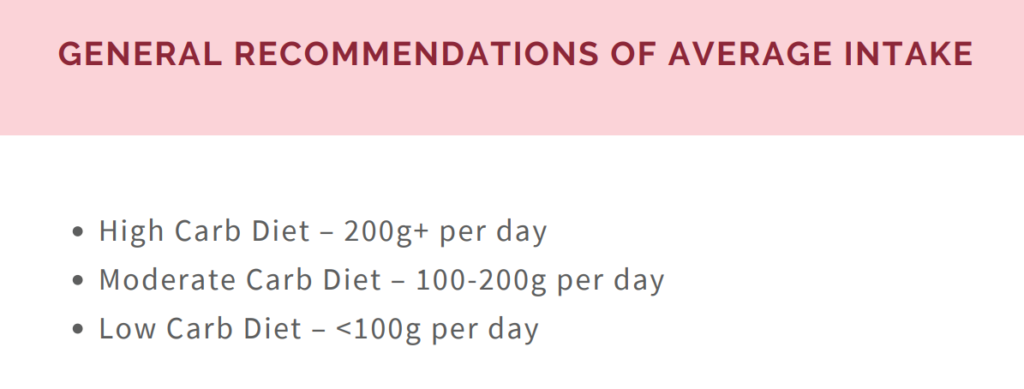
So what’s the general recommendations? What is a lower carbohydrate-based diet? Well, here’s some general recommendations for average intake. But something to note, these recommendations are not for those who are endurance or strength based
Let’s split it up into high, medium and low carb-based diet.
A higher based carb diet is about 200 Plus grams per day, some people do very well on a higher carb diet.
A moderate carb-based diet is about 100 to 200 grams per day of carbohydrates. This is a very common daily carb range for most active and healthy people looking to cut some body fat or feel a bit better.
Lastly, we have a low carbohydrate diet, this is less than 100 grams per day, or this could be described as the start of a ketogenic diet. That’s where one or no starchy carbohydrates or very little are consumed daily, and this is when the body is forced to use fat for energy. To do this, the person will have to go through a fat adaptation phase, this is when the body releases ketones from muscle and brain fuel. This can be the most difficult part of such a diet, as energy levels can significantly drop until this process is complete. The energy slump is also common for those transitioning form. Many lose weight quickly on this type of plan, but it suits those who are inactive, maybe diabetic or seeking that last bit of fat loss.
A low carb diet also works better with females as they carry much less body weight than men, meaning they require less energy as a result.






